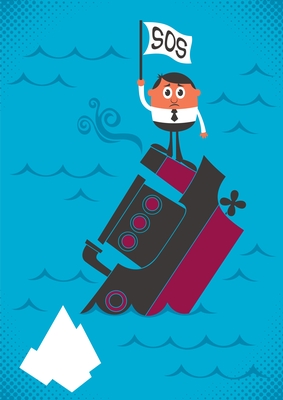The roller coaster of project management can get stressful—especially when you’re working on a project that has taken an unexpected turn for Doomsville. (And sometimes, it’s what’s being said around the office that’s the tell-tale sign your project’s in trouble.) Here, we look at 5 ways to pull your project back from the brink of disaster—or prevent it the next time around.
1. Sign of trouble: “What problem are we trying to solve here?” Midway through any project, hearing this question should trigger a reassessment. It’s time to ask some hard honest questions, like: How has the project veered away from its original aims? What have you achieved so far? Is it enough that you still can accomplish at least some of the objectives? Is it best to stop now or modify the project? You know the project most intimately, so try to step back and look at the big picture with that knowledge of the details. Separate the consequences on your own career (it’s tough) from the best path for the project. If you’re convinced the project can succeed, make a powerful argument to clarify objectives and double-down on completing the project. This experience need not be a personal disaster, but how you finish the project can have broad implications.
2. Sign of trouble: “Failure is not an option.” Of course it is. Projects are risky—and you want to embrace the possibility of failure so that your team develops skills in recognizing signs of trouble and then responding to issues as they present themselves. The trick, as Liquid Planner guest blogger Susanne Madsen notes, is to fail productively: “It’s OK to experiment and to fail—in fact it’s necessary at times. How else can we find that ingenious new solution to our client’s problem?” Failure and mistakes can be productive as long as they propel organizations closer to the end goal. As Madsen states, the danger lies in the “demand for perfection, smooth execution and certainty” that leads people to “choose the safe option which gives them quick wins and fast results.”

3. Sign of trouble: “We should take this in a whole new direction.” This screams scope creep—or a project that’s grown out of its original goals, so address the situation directly. Sometimes, projects rewrite themselves as they get underway and do need to be re-assessed. If this happens, figure out what you need in order to change direction, declare the updated goals and get everyone on board. Identify the resources you have and the ones you’ll need to move forward. Then, reassess—and realign—stakeholder expectations. And lastly, take a lesson from #2, and learn from where the original project plan failed. You don’t want to make that mistake a second time in a row.
4. Sign of trouble: “You’re over budget.” It’s time for a mid-course correction, and it needs to happen soon. First, figure out how you got into this budget mess. Second, identify how to fix it going forward. Third, go to the Guardians of Your Budgets (and your boss) with an improved plan for finishing the project either within the original budget or with a button-down case for what the additional funds will yield. Fourth, learn from the first three steps so next time you can stay within budget—or set a more realistic budget.
5. Sign of trouble: “You’re way behind schedule.” Start by assessing why you’re late: Were key people pulled away from your project? Was the task more difficult than expected? Then devise a plan that goes beyond throwing more bodies at the problem. For example, get more time for your team from key producers. Prioritize needs and scale back on objectives. See if you can get more time from key producers on your team. Unfortunately, working faster or harder (more hours) usually produces more mistakes then getting you closer to your goal. The key here is to be flexible and know how to adapt when you miss the first milestone, because that’s when you’re headed off track. Also, use project management software that alerts you when you’re falling behind schedule before it’s too late.
Have you tried any of these project SOS tactics—and have a tip to add?








